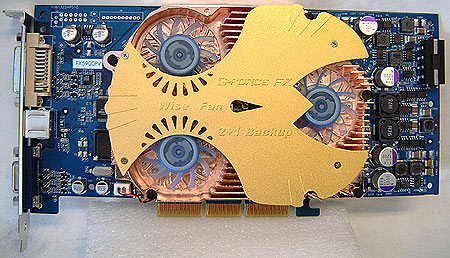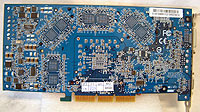Albatron GeForce FX5900PV Videocard Review
For the
last few years, nVIDIA were the undisputed kings of the videocard market. From
high end, to mid range and even budget cards, whatever you little heart
desired nVIDIA could supply. nVidia's videocards were generally reputed to be 'better' than the competition,
and faster too.
When ATI
released the Radeon 9700 Pro VPU in the summer of 2002, things changed
drastically. nVIDIA was no longer top dog, and struggled
to find something in the arsenal to counter the powerful ATI offering. Playing catch
up is something nVIDIA is use to, and while they've managed to remain fairly
competitive in the budget and mid range market, they've taken quite a beating in
the high end arena.
ATI decided to use a 0.15 micron
manufacturing process for their R300 core and experiment with 0.13 micron on
their lower end cards. nVIDIA, who were feeling the
pressure, gambled that their manufacturing partner in TSMC would have the
0.13 micron manufacturing process perfected by the time the GeForceFX 5800/5800 Ultra
was ready to launch.
As I'm
sure everyone is well aware the gamble did not pay off. In
fact it blew up in nVIDIA's face and ultimately cost them market share. Despite all the
"big" numbers like 500 MHz core and 1 GHz DDR2 memory the GeForceFX 5800 Ultra could
not even outperform the by now middle-aged Radeon 9700 Pro. Coupled with an extremely
hot running GPU which required a ridiculously loud fan (FlowFX anyone?),
expensive DDR2 memory prices and worst of all, low manufacturing yields, it was clear the 5800
was doomed right from the start.
With the
GeForceFX 5800 Ultra virtually vapor ware
, nVIDIA engineers quickly
set out to work on the NV35 core. While it's too early to say if nVIDIA are back
in the saddle, the release of the GeForceFX 5900/5900 Ultra nVIDIA is
certainly heading in the right direction.

In this review we'll be examining Albatron's brand
new GeForceFX 5900PV 128MB videocard, which literally arrived at the PCstats Labs hot off the assembly
line.
It is too
soon to say exactly what the retail price of this package is, but nVIDIA's MSRP for
GeForceFX 5900PV based videocards is around $550 CDN ($399 US) so
I would anticipate something similar here.
The FX5900PV comes in a nifty carry case
which through us for a loop as I thought Albatron had sent a notebook by
accident! The Albatron GeForceFX 5900PV is packed securely in a block of
antistatic closed-cell foam inside the nylon notebook style bag, which also
includes a full version of Duke Nukem: MP, a five game demo/lite CD, Power
Director and Power DVD among other items.
Because the card supports VIVO, Albatron also a VIVO break out
box a S-Video to S-Video, and a composite to composite cable. An analog to
DVI converter is also bundled in with the package as well.
Unlike
99% of the GeForceFX 5900PV Ultra's which are built by Flextronics (nVIDIA's
board partner), I'm pretty positive that the Albatron GeForceFX 5900PV is
actually built by Albatron. Albatron have always used a blue PCB for their
videocards and the GeForceFX 5900PV is no different. As you can see Albatron
uses a rather large copper plated aluminum heatsink that has three 'wise'
fans (we'll get a bit more into that a bit later).
| albatron geforcefx
5900pv |
 |
|

|
The Albatron GeForceFX 5900PV
is a long videocard at 22.5 cm, so you may have to remove the
videocard when you're installing system memory. The card only has 128MB of memory that's why
you see silk screens for eight additional DRAM modules. With no memory on the back
of the card and with the core clocked at 400 MHz, the Albatron GeForceFX
5900PV does not require any rear-PCB cooling
Albatron employs the Phillips 7108AE VIVO module with their GeForceFX 5900PV
videocard. These days it's not good enough to have a fast videocard, you must also have
well rounded multimedia options as more and more users are taking advantage of these
features.

